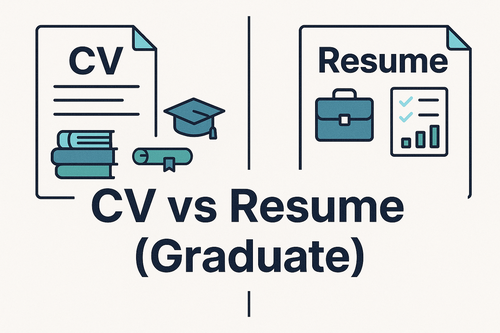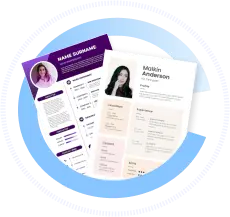Graduate CV vs Resume: What to Use & When
Graduates often face confusion over whether to use a CV or a resume when applying for jobs. The key difference lies in purpose, length, and content. In 2025, knowing when to use each and how to tailor them for industry roles optimizes your chances of success.
| Quick Comparison Overview |
|---|
| CV (Curriculum Vitae) |
| Length: Multiple pages |
| Focus: Complete academic history |
| Used for: Academic, research, medical roles |
| Resume |
| Length: 1-2 pages |
| Focus: Relevant skills & experience |
| Used for: Industry, corporate, most job applications |
What Hiring Managers Look For at This Stage
- Clear, concise presentation of relevant skills and accomplishments
- Tailoring to job requirements using keywords
- Evidence of achievements and potential contributions
- Easy-to-read format compatible with ATS systems
Choose a Simple Format
- CV: Chronological format highlighting education, publications, projects, and awards.
- Resume: Tailored summary plus focused skill and experience sections, often reverse-chronological.
Both should be clean, ATS-friendly, and easy to scan.
What to Include (Projects, Coursework, Skills)
- CV: Full academic background, research, teaching experience, publications, presentations, and relevant certifications.
- Resume: Selective projects, relevant coursework, internships, skills, and professional experience.
Examples You Can Copy
Graduate CV Example (Academic Focus)
- Education: Degrees with thesis titles and honors
- Research Experience: Detailed descriptions with outcomes
- Publications and Presentations: Formatted citations
- Skills: Languages, laboratory techniques, software
Graduate Resume Example (Industry Focus)
- Summary: Tailored to job and key skills
- Experience: Internships or relevant projects with quantified accomplishments
- Skills: Technical and soft skills relevant to role
- Education: Degrees and relevant coursework
How to Tailor to Postings
- Read job descriptions carefully to identify required skills and qualifications.
- Use keywords directly in your resume or CV where applicable.
- Emphasize transferable skills for industry roles on resumes.
- Highlight research and academic achievements on CVs when applying to similar fields.
ATS Basics for Entry-Level Documents
- Avoid complex formatting, images, or tables.
- Use standard fonts such as Arial or Times New Roman.
- Save as DOCX or ATS-friendly PDF (if allowed).
- Organize information under clear headings for ATS parsing.
Templates & Checklist
| Graduate CV vs Resume Checklist |
|---|
| CV includes comprehensive academic info |
| Resume emphasizes relevant skills and professional experience |
| Content is tailored to the specific application |
| Formatting is clean and ATS-optimized |
| Keywords match job description |
| Length is appropriate (CV: multiple pages, Resume: 1-2 pages) |
Fill-in-the-Blank CV Objective:
“Dedicated graduate with a background in [field] seeking to leverage academic research and analytical skills in a [industry/role] position.”
Fill-in-the-Blank Resume Objective:
“Motivated recent graduate aiming to use [skills] to contribute to [company]’s [specific goals].”
FAQ
Q: When should I use a CV instead of a resume?
A: Use a CV for academic, research, or medical roles that require detailed educational and publication history.
Q: Can I submit a CV for industry jobs?
A: Generally, a concise resume is preferred in industry; use a CV only if requested.
Q: How long should each be?
A: CVs can be multiple pages; resumes should not exceed 2 pages.
Q: Should I tailor my CV/resume for each application?
A: Yes, personalized content improves ATS performance and recruiter response.


